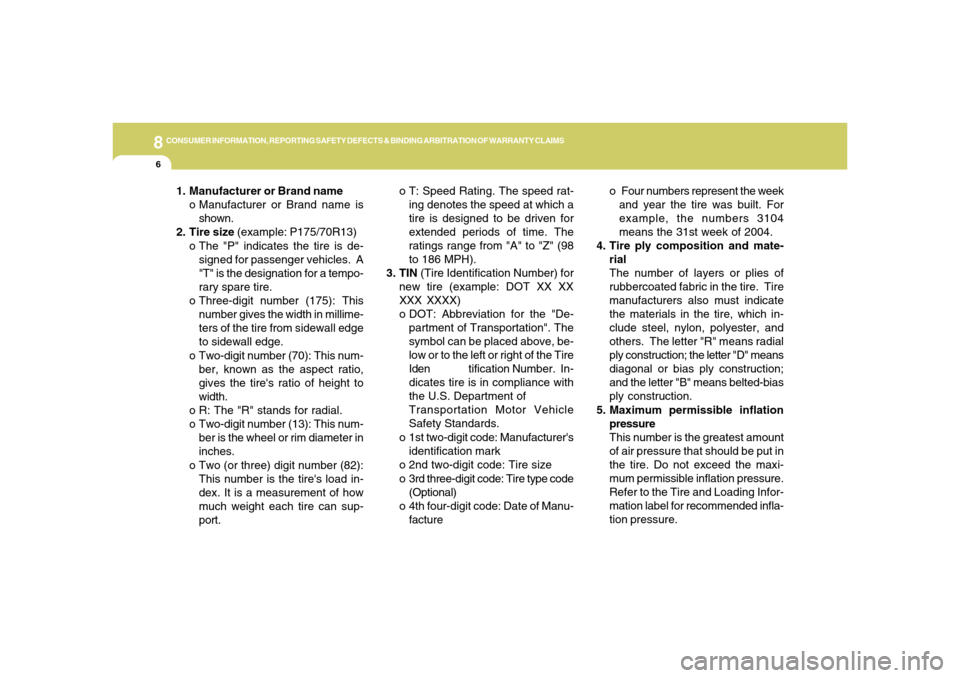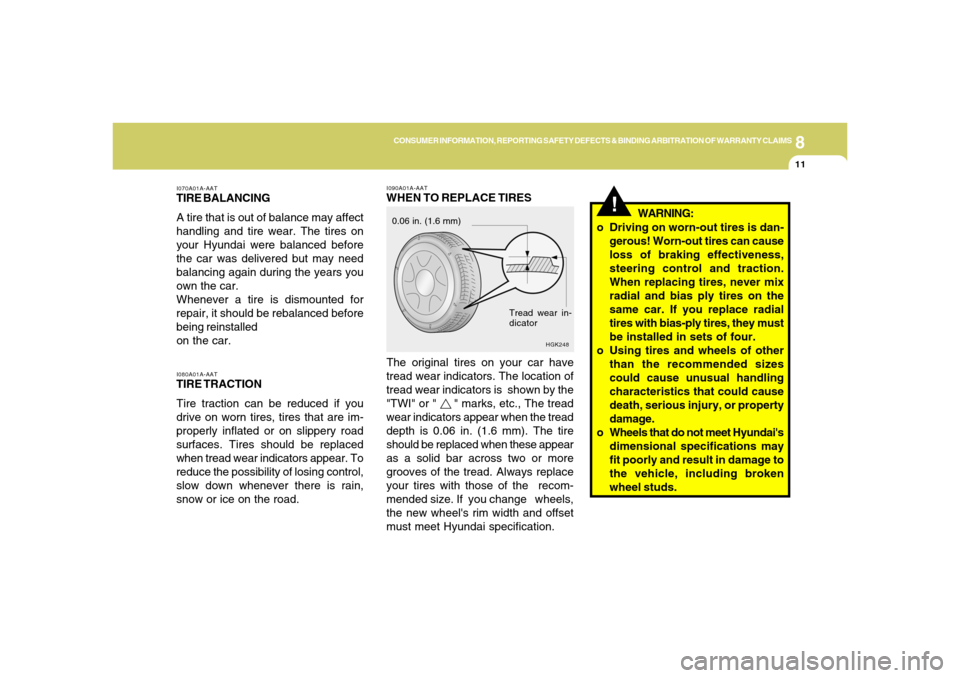wheel size Hyundai Accent 2005 Owner's Manual
[x] Cancel search | Manufacturer: HYUNDAI, Model Year: 2005, Model line: Accent, Model: Hyundai Accent 2005Pages: 219, PDF Size: 7.07 MB
Page 131 of 219

3
WHAT TO DO IN AN EMERGENCY
5
SPARE TIRE
Spare Tire PressureD040A01A-AATThe following instructions for the tem-
porary spare tire should be observed:
1. Check inflation pressure as soon
as is practical after installing the
spare tire, and adjust to the speci-
fied pressure. The tire pressure
should be periodically checked and
maintained at the specified pres-
sure while the tire is stored.
!
Tire Size
Inflation Pressure
T105/70D(R)14
60 psi (420 kPa)
CAUTION:
Serious loss of coolant indicates there is a
leak in the cooling system and this should
be checked as soon as possible by a Hyundai
dealer.
3. Continuous use at speeds of over
50 mph (80 km/h) is not recom-
mended.
4. As the temporary spare tire is spe-
cifically designed for your car, it
should not be used on any other
vehicle.
5. The temporary spare tire should
not be used on any other wheels,
nor should standard tires, snow
tires, wheel covers or trim rings be
used with the temporary spare
wheel. If such use is attempted,
damage to these items or other car
components may occur.
6. The temporary spare tire pressure
should be checked once a month
while the tire is stored. 2. The spare tire should only be used
temporarily and should be returned
to the luggage compartment as
soon as the original tire can be
repaired or replaced.
Page 198 of 219

8
CONSUMER INFORMATION, REPORTING SAFETY DEFECTS & BINDING ARBITRATION OF WARRANTY CLAIMS6
1. Manufacturer or Brand name
o Manufacturer or Brand name is
shown.
2. Tire size (example: P175/70R13)
o The "P" indicates the tire is de-
signed for passenger vehicles. A
"T" is the designation for a tempo-
rary spare tire.
o Three-digit number (175): This
number gives the width in millime-
ters of the tire from sidewall edge
to sidewall edge.
o Two-digit number (70): This num-
ber, known as the aspect ratio,
gives the tire's ratio of height to
width.
o R: The "R" stands for radial.
o Two-digit number (13): This num-
ber is the wheel or rim diameter in
inches.
o Two (or three) digit number (82):
This number is the tire's load in-
dex. It is a measurement of how
much weight each tire can sup-
port.o T: Speed Rating. The speed rat-
ing denotes the speed at which a
tire is designed to be driven for
extended periods of time. The
ratings range from "A" to "Z" (98
to 186 MPH).
3. TIN (Tire Identification Number) for
new tire (example: DOT XX XX
XXX XXXX)
o DOT: Abbreviation for the "De-
partment of Transportation". The
symbol can be placed above, be-
low or to the left or right of the Tire
Iden tification Number. In-
dicates tire is in compliance with
the U.S. Department of
Transportation Motor Vehicle
Safety Standards.
o 1st two-digit code: Manufacturer's
identification mark
o 2nd two-digit code: Tire size
o 3rd three-digit code: Tire type code
(Optional)
o 4th four-digit code: Date of Manu-
factureo Four numbers represent the week
and year the tire was built. For
example, the numbers 3104
means the 31st week of 2004.
4. Tire ply composition and mate-
rial
The number of layers or plies of
rubbercoated fabric in the tire. Tire
manufacturers also must indicate
the materials in the tire, which in-
clude steel, nylon, polyester, and
others. The letter "R" means radial
ply construction; the letter "D" means
diagonal or bias ply construction;
and the letter "B" means belted-bias
ply construction.
5. Maximum permissible inflation
pressure
This number is the greatest amount
of air pressure that should be put in
the tire. Do not exceed the maxi-
mum permissible inflation pressure.
Refer to the Tire and Loading Infor-
mation label for recommended infla-
tion pressure.
Page 201 of 219

8
CONSUMER INFORMATION, REPORTING SAFETY DEFECTS & BINDING ARBITRATION OF WARRANTY CLAIMS
9
Vehicle Capacity Weight: The num-
ber of designated seating positions
multiplied by 150 lbs. (68 kg) plus the
rated cargo and luggage load
Vehicle Maximum Load on the Tire:
Load on an individual tire due to curb
and accessory weight plus maximum
occupant and cargo weight.
Vehicle Normal Load on the Tire:
That load on an individual tire that is
determined by distributing to each axle
its share of the curb weight, accessory
weight, and normal occupant weight
and driving by 2.
Vehicle Placard: A label permanently
attached to a vehicle showing the origi-
nal equipment tire size and recom-
mended inflation pressure
I040A01O-AATSNOW TIRES
If you equip your car with snow tires,
they should be the same size and
have the same load capacity as the
original tires. Snow tires should be
installed on all four wheels; otherwise,
poor handling may result.
Snow tires should carry 4 psi (28 kPa)
more air pressure than the pressure
recommended for the standard tires on
the tire label on the driver's side of the
center pillar , or up to the maximum
pressure shown on the tire sidewall
whichever is less.
Do not drive faster than 75 mph (120
km/h) when your car is equipped with
snow tires.
I040B01JM-AATALL SEASON TIRES
Hyundai specifies all season tires on
some models to provide good perfor-
mance for use all year round, including
snowy and icy road conditions. All sea-
son tires are identified by ALL SEA-
SON and/or M+S (Mud and Snow) on
the tire sidewall. Snow tires have better
snow traction than all season tires an
may be more appropriate in some ar-
eas.I040C01JM-AATSUMMER TIRES
Hyundai specifies summer tires on
some models to provide superior per-
formance on dry roads. Summer tire
performance is substantrally reduced in
snow and ice. Summer tires do not
have the tire traction rating M+S (Mud
and Snow) on the tire side wall. if you
plan to operate your vehicle in snowy or
icy conditions. Hyundai recommends
the use of snow tires or all season tires
on all four wheels.
Page 203 of 219

8
CONSUMER INFORMATION, REPORTING SAFETY DEFECTS & BINDING ARBITRATION OF WARRANTY CLAIMS
11
I070A01A-AATTIRE BALANCING
A tire that is out of balance may affect
handling and tire wear. The tires on
your Hyundai were balanced before
the car was delivered but may need
balancing again during the years you
own the car.
Whenever a tire is dismounted for
repair, it should be rebalanced before
being reinstalled
on the car.I080A01A-AATTIRE TRACTION
Tire traction can be reduced if you
drive on worn tires, tires that are im-
properly inflated or on slippery road
surfaces. Tires should be replaced
when tread wear indicators appear. To
reduce the possibility of losing control,
slow down whenever there is rain,
snow or ice on the road.
I090A01A-AATWHEN TO REPLACE TIRES
Tread wear in-
dicator 0.06 in. (1.6 mm)
HGK248
The original tires on your car have
tread wear indicators. The location of
tread wear indicators is shown by the
"TWI" or " " marks, etc., The tread
wear indicators appear when the tread
depth is 0.06 in. (1.6 mm). The tire
should be replaced when these appear
as a solid bar across two or more
grooves of the tread. Always replace
your tires with those of the recom-
mended size. If you change wheels,
the new wheel's rim width and offset
must meet Hyundai specification.
!
WARNING:
o Driving on worn-out tires is dan-
gerous! Worn-out tires can cause
loss of braking effectiveness,
steering control and traction.
When replacing tires, never mix
radial and bias ply tires on the
same car. If you replace radial
tires with bias-ply tires, they must
be installed in sets of four.
o Using tires and wheels of other
than the recommended sizes
could cause unusual handling
characteristics that could cause
death, serious injury, or property
damage.
o Wheels that do not meet Hyundai's
dimensional specifications may
fit poorly and result in damage to
the vehicle, including broken
wheel studs.
Page 210 of 219

9
VEHICLE SPECIFICATIONS2
Tire Size
P175/70 R13
P185/60 R14
T105/70 D(R)14 in. (mm)
Liter
45Automatic Transaxle
Manual Transaxle
MF12V, 55AH
13.5V 90A
Dual hydraulic with brake booster
Ventilated disc
Drum
Cable operated on rear wheel
Standard
Option
Spare
US. gal
11.9 Fuel tank
capacityImp.gal
9.9Battery
Alternator
Starter0.9 KW
0.7 KW
Type
Front brake type
Rear brake type
Parking brake
Inflation Pressure
30PSI (207 kPa)
60PSI (414 kPa)
J010A01A-AATMEASUREMENTJ020A01A-AATPOWER STEERINGJ060A01A-AATFUEL SYSTEM
J040A01A-AATELECTRICALJ050A01A-AATBRAKEJ030A03A-AATTIRE
4 DOOR
167.7 (4260)
66.1 (1680)
54.9 (1395)
96.1 (2440)
56.5 (1435)
56.1 (1425) Item
Overall length
Overall width
Overall height (unladen)
Wheel base
Wheel tread
Front
Rear
3 DOOR
165.9 (4215)
Type
Wheel free play
Rack stroke
Oil pump type
Rack and pinion
0 ~ 1.18 in (0 ~ 30 mm)
5.3 in. (134 mm)
Vane type